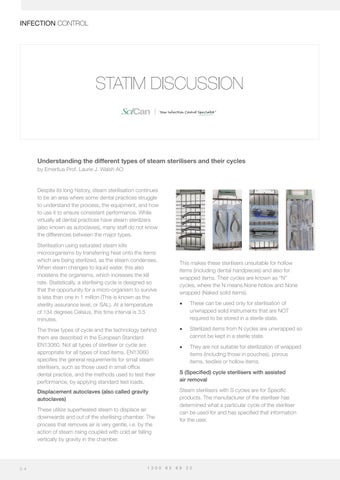INFECTION CONTROL
STATIM DISCUSSION
Understanding the different types of steam sterilisers and their cycles by Emeritus Prof. Laurie J. Walsh AO
Despite its long history, steam sterilisation continues to be an area where some dental practices struggle to understand the process, the equipment, and how to use it to ensure consistent performance. While virtually all dental practices have steam sterilizers (also known as autoclaves), many staff do not know the differences between the major types. Sterilisation using saturated steam kills microorganisms by transferring heat onto the items which are being sterilized, as the steam condenses. When steam changes to liquid water, this also moistens the organisms, which increases the kill rate. Statistically, a sterilising cycle is designed so that the opportunity for a micro-organism to survive is less than one in 1 million (This is known as the sterility assurance level, or SAL). At a temperature of 134 degrees Celsius, this time interval is 3.5 minutes.
This makes these sterilisers unsuitable for hollow items (including dental handpieces) and also for wrapped items. Their cycles are known as “N” cycles, where the N means None hollow and None wrapped (Naked solid items).
The three types of cycle and the technology behind them are described in the European Standard EN13060. Not all types of steriliser or cycle are appropriate for all types of load items. EN13060 specifies the general requirements for small steam sterilisers, such as those used in small office dental practice, and the methods used to test their performance, by applying standard test loads.
•
Sterilized items from N cycles are unwrapped so cannot be kept in a sterile state.
•
They are not suitable for sterilization of wrapped items (including those in pouches), porous items, textiles or hollow items.
Steam sterilisers with S cycles are for Specific products. The manufacturer of the steriliser has determined what a particular cycle of the steriliser can be used for and has specified that information for the user.
These utilize superheated steam to displace air downwards and out of the sterilising chamber. The process that removes air is very gentle, i.e. by the action of steam rising coupled with cold air falling vertically by gravity in the chamber.
1 3 0 0
These can be used only for sterilisation of unwrapped solid instruments that are NOT required to be stored in a sterile state.
S (Specified) cycle sterilisers with assisted air removal
Displacement autoclaves (also called gravity autoclaves)
5 4
•
6 5
8 8
2 2










